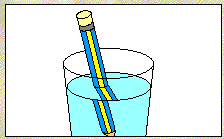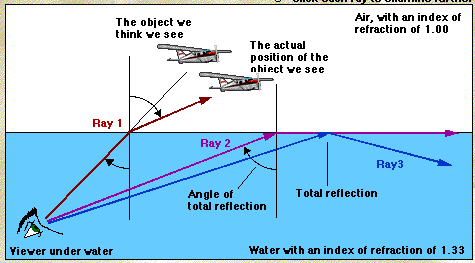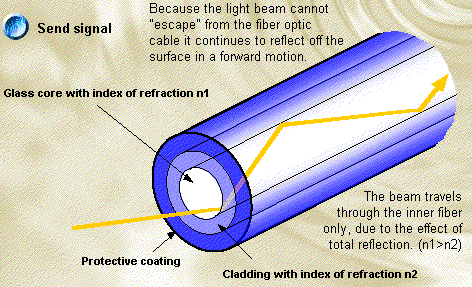INTRODUCTION
This article is part of the "Understanding CCTV Series" and are abstracts from STAM InSight - The Award Winning CCTV Program on CD ROM, which has many innovative CCTV tools for skill and productivity enhancement.
We all know fibre optics is the best transmission method but it’s workings are still a big mystery to many people. This article will demystify some of these issues and provide an overview, and explain the advantages and disadvantages of the fibre optics technology.
WHAT IS FIBRE OPTICS?
To put it simply, fibre optics is a technology whereby a signal like video, data or voice, is modulated on a light beam and sent down a glass tube over large distances, with very little attenuation and loss.
 The principles of fibre optics is simple and easy to understand. All of us have seen the "broken straw" effect in a glass of water. The principles of fibre optics is simple and easy to understand. All of us have seen the "broken straw" effect in a glass of water.
When light travels from air to a denser medium, like glass for example, the light slows down by a factor equal to the optical index of the material and this slow down in speed results in the bending of the light beam. This phenomenon is seen in our daily life on a regular basis. The beautiful colours in a diamond occur due to the same reason.
 As shown in the example when we see an object from underwater, the object is not in the actual position as we think because light bends travelling from water to air. When this angle of entry is increased, there would come a stage when the light is reflected back into the same medium, as shown in ray 3. This angle is called the angle of Total Reflection. Fibre Optics uses this simple principle for transmission. The core of the fibre optics cable, which is made of glass has an higher index of refraction than the index of the cladding, which covers this core. So when light is injected into the glass core at the correct angle, it will reflect back from the surface and continue doing this in its forward travel. In other word the light cannot "escape" from the fibre optics cable. As shown in the example when we see an object from underwater, the object is not in the actual position as we think because light bends travelling from water to air. When this angle of entry is increased, there would come a stage when the light is reflected back into the same medium, as shown in ray 3. This angle is called the angle of Total Reflection. Fibre Optics uses this simple principle for transmission. The core of the fibre optics cable, which is made of glass has an higher index of refraction than the index of the cladding, which covers this core. So when light is injected into the glass core at the correct angle, it will reflect back from the surface and continue doing this in its forward travel. In other word the light cannot "escape" from the fibre optics cable.
 It is easy to modulate any signal, whether it be video, data or voice, on to light and send it into a cable, where it can not escape and it has to travel in the forward direction. In the other word, this light beam carries the signal through the glass core of the fibre optics cable. It is easy to modulate any signal, whether it be video, data or voice, on to light and send it into a cable, where it can not escape and it has to travel in the forward direction. In the other word, this light beam carries the signal through the glass core of the fibre optics cable.
Top
COMPONENTS OF A FIBRE OPTICS SYSTEM
The use of fibre optics is extensive, but the components used to make up a system are usually similar. These are:
- Input Modulator: This modulates the incoming signal with a light beam
- Light Emitting Device: This generates the light for modulation, which is in the infrared frequency range. The higher the frequency, larger the bandwidth of the signal.
- Fibre Optics Cable: There is a range of cables which are available to suit different applications.
- Light Receiving element: Which receives the light signal at the other end.
- Output Demodulator: This separates the signal from the light beam.
All fibre optics systems use the above components. The specification of each component will vary depending on the application and use. For example a LED ( Light Emitting Device) will be adequate for CCTV as the light source, but a LD (Laser Diode) is a must if higher band widths are required.
DIFFERENT TYPES OF FIBRE OPTICS CABLE
There are 3 different types of fibre optics cable available. These are
- Step Index :
This cable has a distinct index of refraction for the core and the cladding. It is the cheapest type of cable and causes deformation due to the various path lengths of the light ray. This is called modal distortion.
- Graded index or multimode :
In order to equalise the path lengths and improve pulse response, the multimode cable was developed. The index of refraction of the core is varied in smooth fashion. This would mean the angel of reflection would vary, which helps in equalising the path lengths and reduce distortion.
- Single mode :
The single mode has the best pulse response because the diameter of the core is very narrow and the light wave virtually goes straight. Obviously this the most expensive cable.
ADVANTAGES OF FIBRE OPTICS
Fibre Optics signal transmission offers many advantages over existing metallic links. Some of these are:
1. Large Bandwidth
Fibre optics offers very high bandwidths as compared to copper wire. The bandwidth of a fibre optics cable is between100Mhz to 1000 MHz as compared to a copper wire, which can handle only 3 to 20 MHz. This large bandwidth allows many applications and uses of fibre optics. For example a video signal has a bandwidth of 5 MHz. It is therefore possible to send up to 20 - 200 video signals on a signal fibre optics cable. This is impossible with a copper wire. In fact by using digital compression techniques you could modulate up to 500 - 1000 video signals on a single cable.

Top
2. No Interference
Unlike coaxial cable which uses electric currents, fibre optics uses light making it immune to any type of interference
- No EMI interference - As light is the medium of transmission, fibre optics cable does not pick up Electro Magnetic Interference (EMI). EMI is the biggest source of problems with co-axial cable. Double images, moving lines, horizontal bands and picture snow in a video picture are due to EMI. All these are eliminated with the use of fibre optics.
- No ground loop currents - Ground loop current is caused when the two ends of the cable are not grounded to the same potential. This difference in potential causes a current, which is usually seen as a moving lines on a video picture. Fibre optics does not use electricity and therefore ground loop currents are impossible.
- No power interference - Voltage has no effect on light beam. It is therefore irrelevant whether the fibre optics passes next to 240VAC or 10000 VAC, or close to a powerful transmitter. This has no effect on the light beam in the fibre optics cable.
- Immune to lightning - Even lightning that hits a centimetre away from a fibre optical cable cannot induce any voltage in it.
Fibre optics cables are very small and low in weight. It is therefore much easier to lay fibre optics cable compared to metallic cable, which can be heavy and bulky.
3. Security of information
It is impossible to tap into a fibre optics cable without physically intercepting the signal, in which case it is detectable at the receiving end.
DISADVANTAGES OF FIBRE OPTICS
- Cost of fibre optics cable.
Fibre optics is still quite expensive as compared to the copper wire, though the prices are coming down rapidly. This disadvantage could be made into an advantage by using innovative cabling and installation methods. In co-axial cable, a single cable has to be run from the camera point to the control room. As fibre optics has large bandwidths, it is possible to multiplex many video signals on a single fibre optics cable and thereby reduce cabling and installation cost. For example in the Ring Method, a single fibre optics cable is run all over the site and the cameras are connected to this cable and the video signals are multiplexed at different frequencies.
- Termination
Termination of fibre optics cable is complex and requires special tools, better precision of workmanship and is more time consuming and therefore more expensive. Fibre optics cable has a very small diameter and require specialised tools to align the cables correctly and then join them. The glass in the fibre optics core has to be grounded flat first to ensure correct alignment for proper and smooth termination. This looks complex, but many tools are available to ensure that the termination etc. can be achieved more easily.
- Cable laying
The centre core of a fibre optics cable is made of glass. Extra precaution is required during cabling. Stretching of cable should be avoided as the glass core may crack. Also the cable bending is a major problem. Sharp bends could crack the cable but also the light beam bouncing of the glass core may not handle the bend and the light beam may ‘escape out’ of the core. Most cable manufacturers provide permissible bending angles.
There is no denying that the advantages definitely outweigh the disadvantages. There are more benefits into using fibre optics. It is because of these facts the usage of fibre optics is growing daily.
About the author
Jayant Kapatker,
President, STAM Interactive Solutions Inc.
Jayant has 20 years experience in the CCTV industry. This article is part of the popular web based training course: CCTV - A Complete Review. For more details contact.
Tel: +1 609 750 9827, Fax: +1 609 750 1936
email: info@staminteractive.com
Web: www.staminteractive.com |

